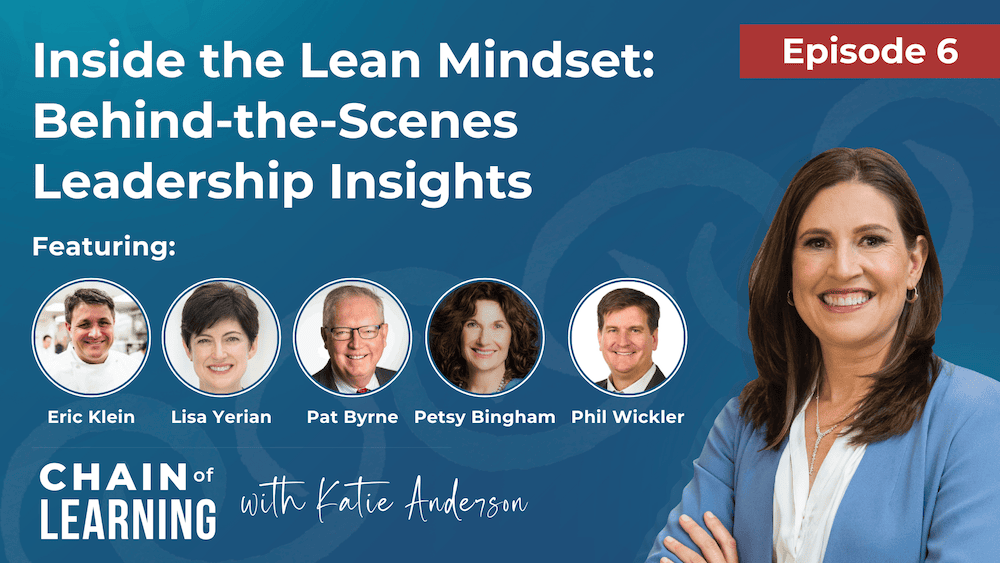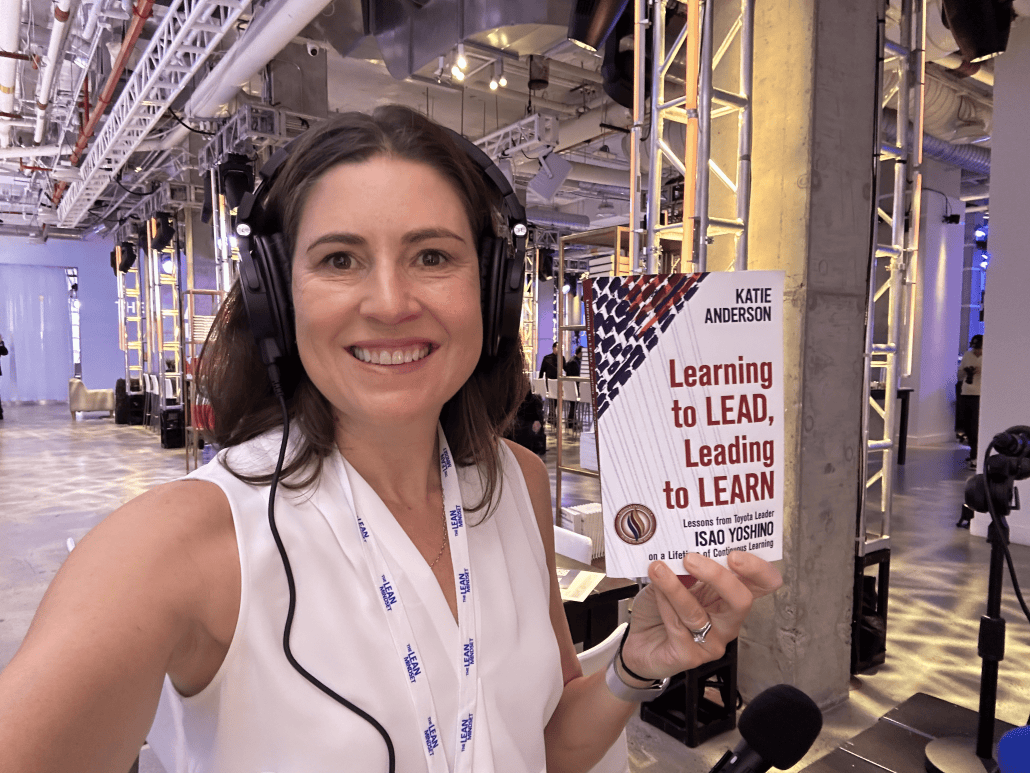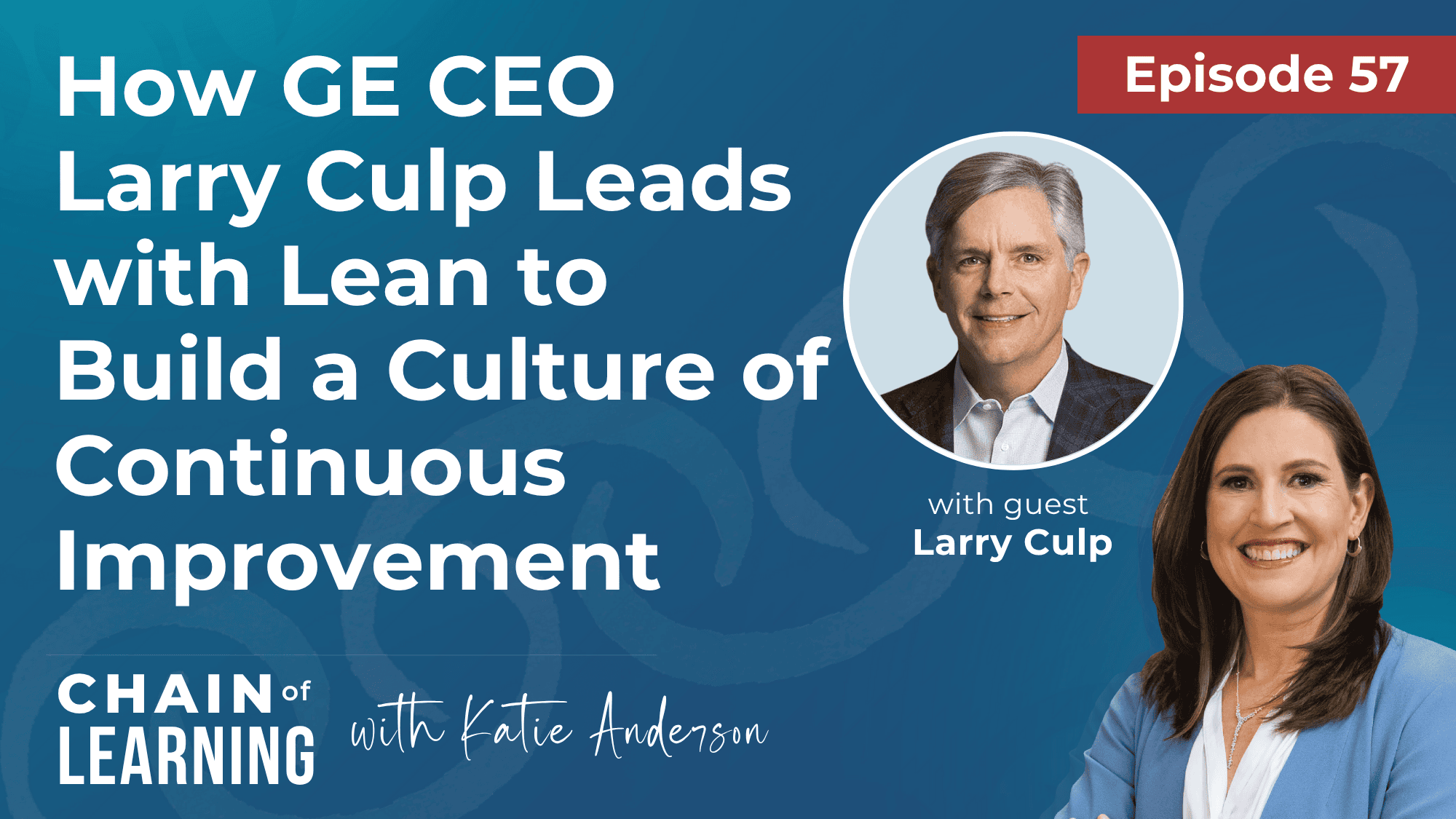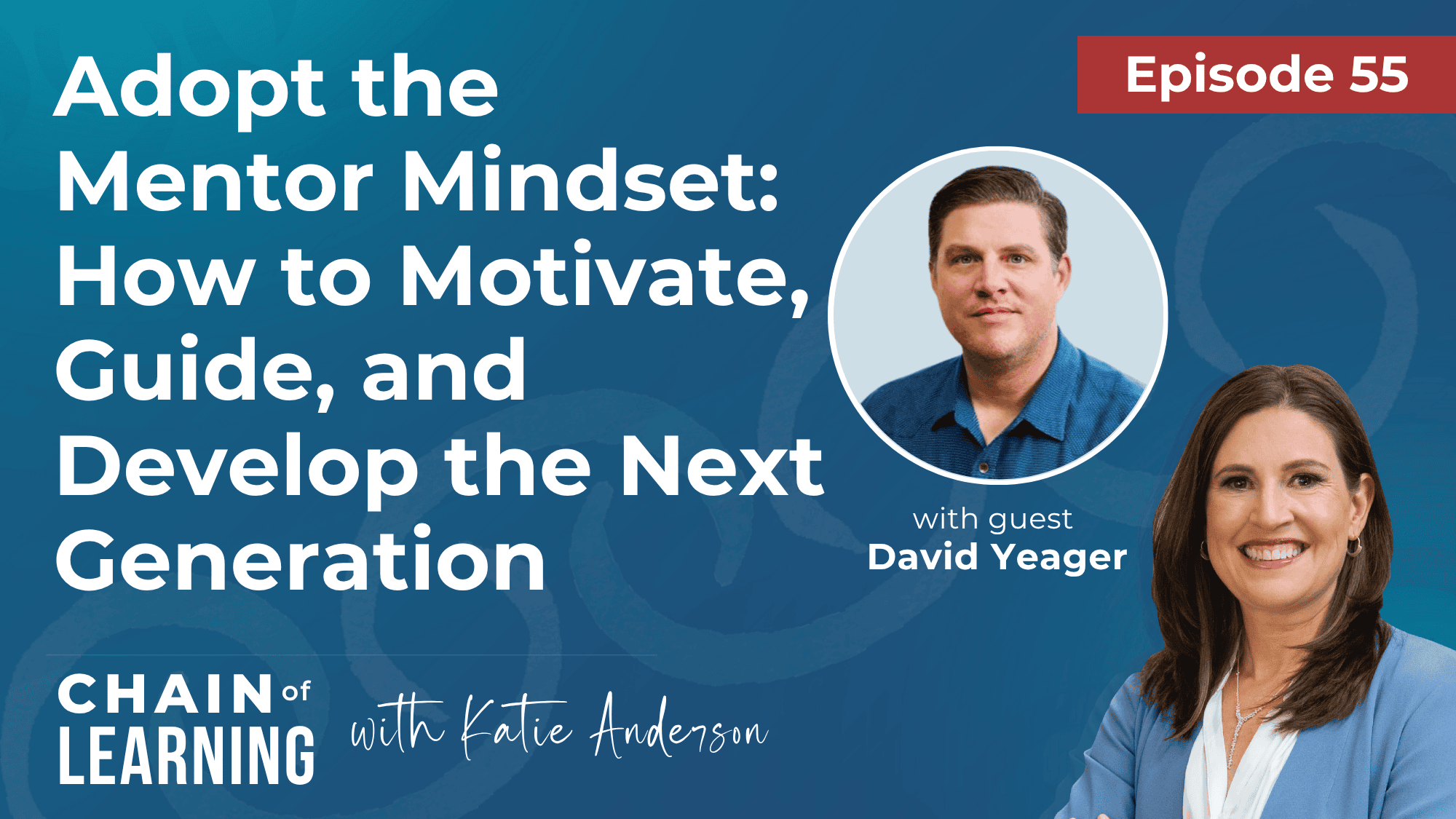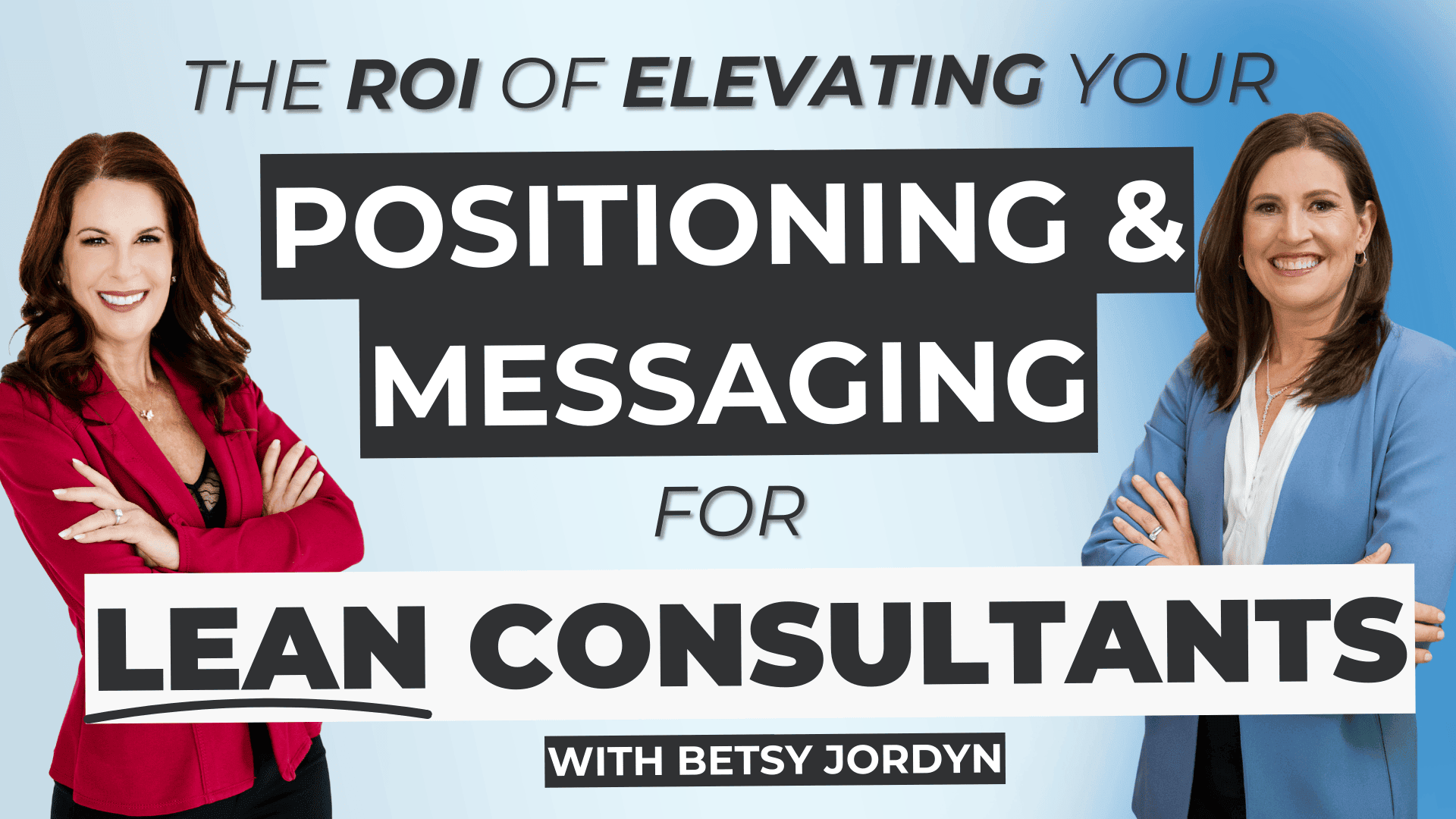What does a Lean Mindset mean to you? What steps can you take to create a culture of continuous improvement? What behaviors make you a more effective transformational leader?
In the workplace, often the most valuable insights often happen during informal moments. It’s these pockets of space, in between meetings and events, where casual, off-the-cuff conversations take place and ah-has emerge.
Quick question, have you ever wondered what it would be like to listen in to these “hallway” conversations to discover what leaders say and reflect on with each other?
If you’re curious, you’re in the right spot. In this episode of Chain of Learning, I take you behind-the-scenes with exclusive conversations I had with transformational change leaders and executives in attendance at GE’s The Lean Mindset event.
This exciting event, hosted by Larry Culp, Chairman and CEO of GE and GE Aerospace, brought together executives from some of the world’s top companies, professional athletes, and thought leaders all focused on pursuing excellence through continuous learning.
Thanks to GE’s generosity, I was invited to both share my knowledge (GE bought a copy of my book Learning to Lead, Leading to Learn for all the attendees!) ,and to collect knowledge – by bringing my microphone to glean insights from the leaders in attendance during the spaces between the main stage events.
I can’t wait to share them with you here on the latest episode of Chain of Learning!
Behind-the-scenes at GE’s The Lean Mindset
This is an episode you won’t want to miss!
You’ll hear powerful excerpts from the conversations I had with these leaders, sharing their views of a Lean Mindset and how they’ve activated cultures of continuous improvement and high performance in their organizations.
My aim is simple: ignite your curiosity and furnish invaluable insights to propel you to your next level of leadership in your organization!
Tune into the episode to discover how you can lead with humility, embrace failure, and foster a culture of continuous learning and more.
You’ll hear excerpts from my exclusive conversations with senior change leaders and executives including:
✅ Eric Klein – Culinary Vice President and Partner at Wolfgang Puck Catering, who also led the production of the breakfast and lunch service using continuous improvement lean practices
✅ Dr. Lisa Yerian – Chief Improvement Officer at The Cleveland Clinic, who was also one of the mainstage speakers
✅ Betsy Bingham – Vice President of Lean Operations at GE Aerospace
✅ Phil Wickler – Chief Transformation Officer for GE Aerospace
✅ Pat Byrne – Senior Vice President for Operational Transformation at GE
If you are trying to create a high-performing learning organization, you won’t want to miss these invaluable behind-the-scenes leadership insights.
Hit play now to be inspired about how you can embed a lean mindset in your organization and accelerate your impact as a change leader.
Lean Mindset Insights and Key-Takeaways
In this episode you’ll learn:
The importance of embracing and learning from failure
The power of humility, empathy, and making daily connections with your team
Strategies to empower problem-solving and teamwork, including going to gemba, leveraging meaningful metrics, and created structured approaches to improvement
The mindset and behavior shifts leaders need to make to build effective leadership habits and lead by example
How being an effective leader doesn’t mean you have all the answers; it means you’re willing to ask questions, go see, and always keep learning
Tune in to discover even deeper insights and leadership tips from my guests, such as these topics below.
Eric Klein’s Insights on Embracing Failure
Eric Klein, Vice President of Culinary and partner at Wolfgang Puck Catering, shares the importance of embracing failure as a source of learning and leading by example to create the culture you want in your team.
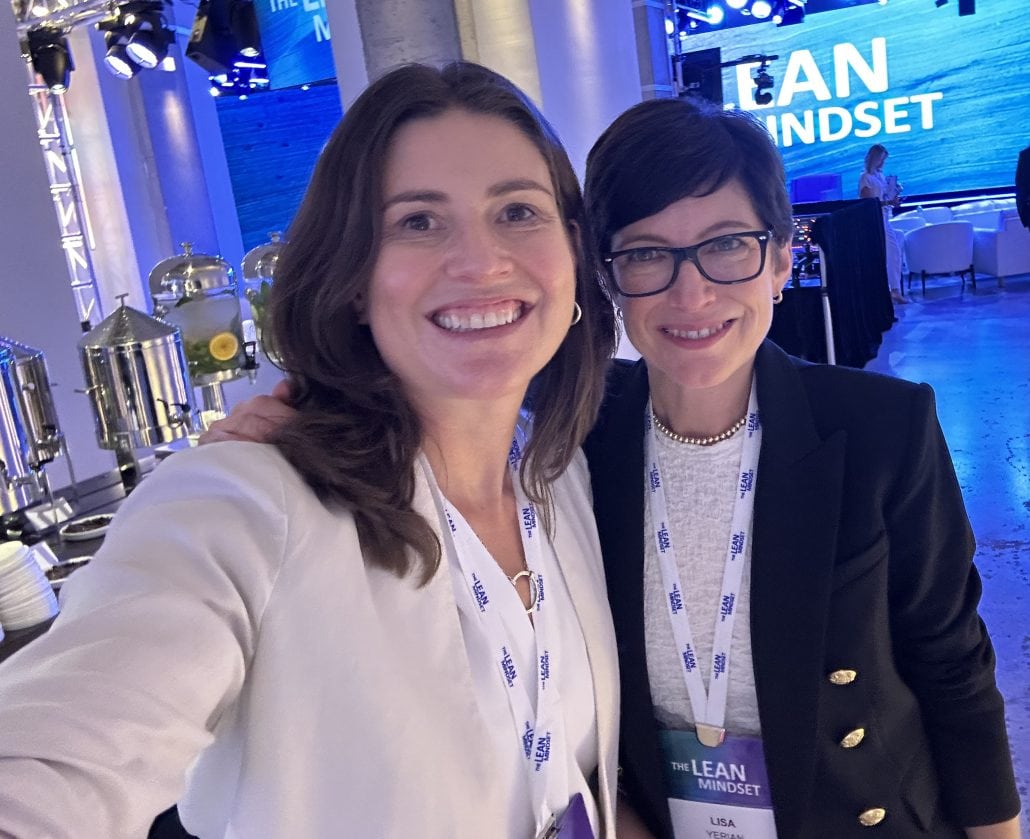
Dr. Lisa Yerian on Shifting Your Leadership Mindset
Dr. Lisa Yerian, Chief Improvement Officer at The Cleveland Clinic, opens up about her leadership mindset shift and how she balanced humility and a hunger for performance helped create an environment where others feel safe and empowered to bring problems forward.
Betsy Bingham on Problem-Solving
Betsy Bingham, Vice President of Lean Operations at GE Aerospace, offers insights into effective problem-solving, emphasizing the importance of the human element and clarifying the real problems to solve.
Phil Wickler Explores the Importance of Gemba
Phil Wickler, Chief Transformation Officer for GE Aerospace, sheds light on the significant impact of getting out of your office and “going to Gemba” (the place where work happens) to show respect for people.
Pat Byrne’s Insights on Learning in Gemba
Pat Byrne, Senior Vice President for Operational Transformation at GE, also emphasizes the impact of going to Gemba has for learning, creating a problem-solving culture, and understanding customers’ needs.
Unlearning Command-and-Control Leadership
Betsy Bingham shares insights on how she learned to balance being directive with asking questions to foster team learning and engagement – and more efficient problem-solving.
The Value of Repetition and Structures for Practice
Pat Byrne shares the pivotal role of practice and repetition to create habits aligned with a Lean Mindset, and Dr. Lisa Yerian
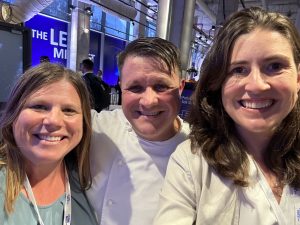
discusses how daily team huddles can give the structure for leaders to practice those “good reps” fostering improvement and learning.
Leveraging Metrics for Improvement
Several of the GE lean leaders discuss how to effectively leverage metrics to serve as drivers of operational improvement by ensuring they are aligned, actionable, and relevant.
Embracing Problems and Breaking the Telling Habit
My guests highlight the importance of embracing problems and resisting the leadership urge of always solving the problem and giving their answer, and share how they have worked to “Break the Telling Habit.”’
Strategies to Cultivate Lean Mindset Practice and Culture
The discussions wrap up with strategies and practices of how to personally put a Lean Mindset into practice, and how to integrate it into your organizational culture. You can also discover the three key takeaways from the Lean Mindset Event and recommendations from GE Chairman Larry Culp.
Reflect and Take Action
As you listen to this podcast episode, reflect on these insights from my behind-the-scenes interviews with transformational change leaders and executive and how you can apply them to amplify your impact and foster a learning culture in your organization:
- What is one thing you learned from this episode that you can put into practice this week?
- How will you continue to improve as a leader or lean practitioner?
- How can you foster a Lean Mindset in your organization?
Building a Chain of Learning
I loved Larry Culp’s closing remarks and reminding us that leadership it’s not just about us as leaders or how we improve ourselves. Lean is a team sport.
I personally loved hearing this comment because it reinforces what this podcast is all about. When we connect and communicate openly, sharing our experiences and lessons from failure and success, we are building a strong team committed at every level to continuous improvement.
When we embrace the attitude that we can all learn from each other. And, when we do this consistently and with intention, we strengthen our chain of learning – sometimes one link at a time, and sometimes, by lengths.
This is a Chain of Learning®.
Now you are a part of that chain and you have the opportunity to strengthen it by putting in place what you learned today and sharing this episode with your colleagues and friends!
Listen now to Inside the Lean Mindset on Chain of Learning®
Listen to the podcast on your favorite podcast player. The full list of podcast player apps can be found here.
You can also watch this episode of Chain of Learning on YouTube.

Important Links
- GE’s The Lean Mindset Event videos
- My initial key takeaways from The Lean Mindset event
- My book Learning to Lead, Leading to Learn
- Episode 2 of Chain of Learning: “Leading with the Heart to Create a Culture of Continuous Learning”
- Episode 3 of Chain Of Learning: A Growth Mindset is the Foundation of a Continuous Improvement Culture [with Carol Dweck]
- Follow Katie on LinkedIn
- Follow Eric on LinkedIn
- Follow Lisa on LinkedIn
- Follow Betsy on LinkedIn
- Follow Phil on LinkedIn
- Follow Pat on LinkedIn
And be sure to check out Mark Graban’s article highlighting the Wolfgang Puck’s team putting together the food at the event.
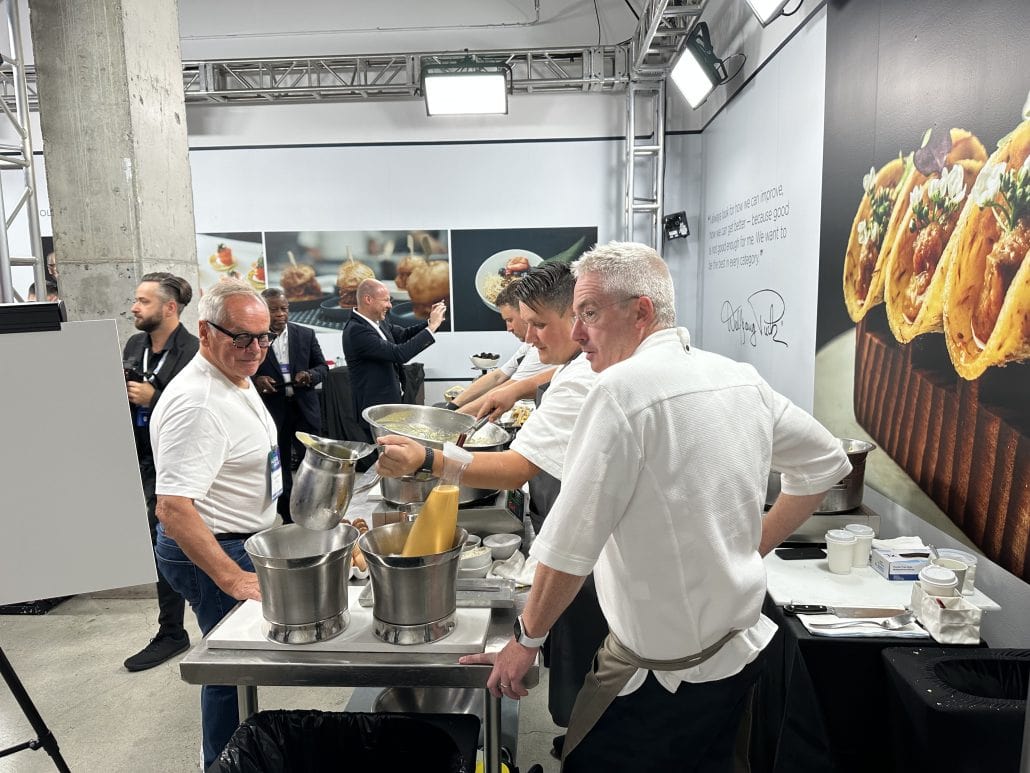
Listen now!
Listen now on your favorite podcast players such as Apple Podcasts, Spotify, and Audible. More podcast players can be found here.
Timestamps:
00:00 – Introduction to the episode
00:55 – Delving into the Insights from GE’s The Lean Mindset Event
01:27 – Reflecting on personal interactions at the event
01:40 – A deep dive into the principles of lean management
02:38 – Presenting the esteemed lineup of leaders
03:10 – Overview of themes covered at the lean mindset
04:14 – Excerpt from Chef Eric Klein: exploring the lean mindset in a kitchen
05:14 – Emphasizing the importance of humility and the willingness to embrace failure to evolve as a learner
05:59 – Dr. Lisa Yerian discusses balancing humility and hunger in leadership
07:16 – Betsy Bingham on problem-solving and the human element
08:04 – Phil Wickler shares Insight on the significance of Gemba
08:55 – Pat Byrne explores the importance of Gemba for both employees and customers
09:35 – Betsy Bingham on problem-solving efficiency
10:57 – Recognizing the value of repetition to build lean mindset skills
11:42 – Dr. Yerian reinforces the importance of quality repetition
12:35 – Leveraging metrics to drive operational improvements
15:35 – Embracing challenges and how to approach to problem resolution
16:35 – Benefits of breaking the telling habit for effective leadership
17:35 – Insights on cultivating a lean mindset within your organizational culture
22:30 – Larry Culp’s three key takeaways
23:50 – Closing thoughts on the event and inspiring team dynamics
Full Episode Transcript
Katie Anderson : What happens when you put 120 leaders, all passionate about continuous improvement and high performance into a room? No, this isn’t a setup for a joke. In fact, as it turned out, it was a setup for elevated leadership learning. Welcome to Chain of Learning, where the links of leadership and learning unite. This is your connection for actionable strategies and practices to empower you to build a people centered learning future, get results, and expand your impact so that you and your team can leave a lasting legacy.
Katie Anderson: I’m your host and fellow learning enthusiast Katie Anderson. In September 2023, I was invited to attend GE’s, the Lean Mindset event in New York City, hosted by Larry Culp, GE Chairman and CEO and CEO of GE Aerospace, as an influencer in continuous improvement leadership. I had the pleasure of interviewing Larry Culp on stage at the AME Annual Conference back in 2022 about how he was leading with lean at GE. And I was excited to be part of this incredible event this year showcasing the value of a lean and continuous improvement mindset as the way to achieve personal and organizational impact. Not only were the folks at GE interested in having me share my knowledge by providing my book Learning to Lead, Leading to Learn as a gift to all attendees, but they also invited me to collect knowledge by giving me and my microphone access to the speakers and my fellow attendees during and after the event.
Katie Anderson: These conversations reinforced for me that lean leadership can take on many different forms and serve organizations in a myriad of ways, regardless if you call it lean or just consider it good leadership, and that each individual has to take personal responsibility for their growth and embody the change that they want to bring to their organization. I’ve already shared some takeaways from the Lean Mindset event in earlier episodes of Chain of Learning, including episode two Leading From the Heart to Create a culture of continuous Learning, and my discussion with Stanford Professor Carol Dweck, an author of Mindset, in episode three, A Growth Mindset is the foundation of a continuous improvement culture. The links for these episodes are in the show notes, and be sure to check them out, as well as the videos from all the speakers at GE’s YouTube channel. In this episode, I’m sharing some of the hallway conversations that I captured to spark a sense of possibility in you and provide insights for your ongoing evolution as a leader and continuous improvement practitioner, no matter what industry you’re in. While the lineup of speakers included senior executives at organizations such as GE, PG E, Uber, Ford, and the Cleveland Clinic.
Katie Anderson : One of the things I really appreciated about GE’s Lean Mindset event was that Larry Culp and his team didn’t limit their definition of leadership to just traditional businesses or to leaders who would have used the word lean prior to the event to describe their leadership approach. The uniting theme was a commitment to a continuous improvement mindset and a passion for pursuing excellence through learning, teamwork, and caring leadership. Giannis Antetokompo, the power forward of the Milwaukee Bucks basketball team, was one of the professional athletes there to share what we can learn from leadership in sports and the pursuit of excellence by learning from failure. Retired Navy Admiral William Lesher spoke about applying lean and continuous improvement principles to transform key military processes and culture. And Laura Kavanaugh, Fire Commissioner of the New York City Fire Department, talked about how to enable a culture of safety and innovation.
Katie Anderson : Even the food industry was represented, with master chef Wolfgang Puck in attendance, as well as his Vice President of Culinary and partner in Wolfgang Puck Catering, Eric Klein. This is the company that famously provides food service for large scale events like the Oscars and the Lean Mindset event, too. I had a fantastic conversation with Eric immediately following the event. As the tables and chairs were being broken down. I could see that he was lit up by the potential that lean leadership opens up in his kitchens and where his practices overlap with the Lean Mindset.
Eric Klein: What I learned is constantly listening, being a mentor, be a teacher, understanding there is a problem, and I think it’s so much out there. How can we evolve? How can we do things in a different way, how to simplify it all our life, from the beginning we’re born to now. We start learning how to walk, how to communicate, how to write things down, sharing, passing on what we have learned. A good experience, a bad experience, a failure.
Katie Anderson : He further explained how he embraces failure as a key learning practice before you.
Eric Klein: Successful, you will fail. Failing is the most important thing because it will allow you not to make that mistake again. But the most important thing is the outcome. As a leader, you have to understand to surround yourself with people. You don’t have to know everything.
Eric Klein: I don’t know everything. I’m the first one in a meeting when I say I’m sorry, I did not know.
Katie Anderson : Coming at leadership with humility and humbleness was a regular theme in the conversations I had with other leaders. As Eric pointed out, being willing to fail is a part of that, as is letting go of the idea that you know everything you need to know. This egoless approach shifts how we address problems that arise? How do we deal with failure and problems humbly and yet still demonstrate the ambition and action our team needs from us.
Katie Anderson : Dr. Lisa Yerian, the chief improvement officer at the Cleveland Clinic, was another speaker at the event. She and I have known each other for many years, and I was able to capture some in the moment reflections with her. On one of the breaks, I asked about how she deals with the dichotomy of being both hungry and humble.
Lisa Yerian: I think that for myself, it was more about balancing that with the confidence and clarity that’s required to step forward and say yes, I want to talk about problems openly, knowing that I wouldn’t be able to solve them and I may not actually be able to help the teams solve them. And as I worked with Lean practitioners during my career, I began to pick up these little pieces, phrases that they say that were so powerful to shifting my mindset. One team member once said something like, well, at the end of the day they’re just problems. And this idea that they’re just problems and if they’re problems we can solve them. And that confidence that it brings to me as a leader as I talk with others about creating environment and escalating problems, I actually think that part of the reason that leaders maybe don’t always ask their team for problems is because they’re afraid they’re not going to be able to solve them.
Katie Anderson : It’s such a refreshing reframe to detach from the problems so that you can move forward with solving them, but first you need to know what those problems are. This is one of the key learnings that Betsy Bingham, Vice President of Lean Operations at GE Aerospace, shared with me when we spoke after the event about our experience there.
Betsy Bingham: I think where I have learned to start is really number one, meeting people where they are and really understanding what are the problems that they’re dealing with, where are the opportunities that they wish they could capitalize more. And then with that understanding of where they would like to go or where their challenges are, then let’s talk about how we can begin to break those down into things that we could do something about.
Katie Anderson : In the world of Lean leadership, the concept of going to where the challenges are happening, to learn more about them and to check in with people is called going to Gemba or going to the place where work happens. This came up quite a bit with leaders and attendees as a strategy to implement. Phil Wickler is the chief transformation officer for GE Aerospace.
Phil Wickler: I think it starts with now, everybody gets busy as a leader. But I think the minute you realize, you got to know where the value is created and it’s not in our offices. And going to the gemba to understand what issues and waste is occurring and really as part of respect for people, really focusing on how you can make their job easier, it might not be the biggest impact to start. It might just be a more comfortable chair. It might just be a way to eliminate some steps, but that’s going to start to get their buy in and see that you respect what they’re doing and ultimately you are trying to eliminate waste to make it better for the customer.
Katie Anderson : Pat Byrne is a senior vice president for operational transformation at GE. He agrees with the importance of going to Gemba because of the communication opportunities. It provides for leaders, team members and customers.
Pat Byrne: And a lot of it is not just those tools, it’s the leadership engagement in leading that way, where leaders are asking more questions than they are giving advice and they’re trying to help teams in the discipline of hey, did we really understand the root cause of that? Do we know where the problem is concentrated? Have we gone to see the customer or gone to the point of impact to really understand how the work is done and the leader role shifts as we’re teaching and developing the capability of the organization to do this kind of work.
Katie Anderson : Curiosity around problems and efficiencies is a key part of the Lean Mindset. As leaders, this can sometimes be difficult to navigate. Betsy Bingham shared why it might be a challenge for leaders.
Betsy Bingham: You know in my career I’ve always run big supply chains, been sort of a command in Know, here’s what we got to do and here’s how we’re going to do it. And as I really developed more of a Lean Mindset, I found that I needed to direct less and I needed to ask more and seek to understand. And so for me, being able to really ask the right questions at the right time to get the team engagement and to get the most out of your team is probably the biggest change that I’ve had to make. And we’re all taught in our MBA schools and all that, that you’ve got to lead in a certain way and I think in a lot of ways that doesn’t do us well as we develop that Lean Mindset. So I think if you can keep the right balance between the hey, here’s where we got to really be directive, but most of the time, I find you get better results by really engaging and understanding and supporting and taking roadblocks away from the team, as opposed to just telling them to go do something and come back when you’re done.
Katie Anderson : A Lean Mindset is about continuous learning and Lean leadership is all about inspiring others to put these principles into practice. And practice is the name of the game as far as Pat Byrne is concerned.
Pat Byrne: It’s building on all the great things that are already inside of GE, but focusing more on not just on the financial results, but on the operating levers that drive those and then these building blocks that I mentioned that allow us to achieve a performance from where we currently are and then where do we need to get? And a lot of ways this is like repetition. I tell people that lean is a lot more like golf than chemistry. It isn’t about reading a book, it’s about reps. It’s about reps and good teaching.
Pat Byrne: Reps and good teaching. And if you get good reps in, good repetition in and you get good instruction, good coaching, you get better.
Katie Anderson : Dr. Lisa Yerian agrees and says that daily huddles are a great addition to good reps.
Lisa Yerian: Previously, I’ve heard Larry talk about good reps, and you need to get good reps. Good reps can occur every single day. If you have a huddle, you talk about problems and you practice saying thank you to your team, you practice solving them effectively. You practice that behavior that you want to emulate. So I think it’s incredibly powerful for the organization, both from a leader commitment and credibility point of view, but also from a very practical point of view that your team actually has somewhere to go with the challenges that they’re facing on a daily basis.
Katie Anderson : We didn’t just talk about best practices for lean leadership behaviors. The attendees were also generous in sharing the pitfalls they’ve discovered in creating an effective lean culture and management system and how to avoid them. Both Betsy Bingham and Pat Byrne talked about how to use metrics effectively to drive operational improvement.
Betsy Bingham: Yeah, so a lot of times we look at our metrics once a month and spend our time trying to understand why did we get the outcome that we got? And that’s really just reporting the news and reconciling. And if you really want to connect improvement to a daily sort of cadence, you want to get to metrics that really are managing the metrics as opposed to just reporting. So, as an example, I know in our business, when I first started, we would report on time delivery, and our on time delivery was at a point where we just had misses that we talked about. And so what we started to get into is a rhythm where you actually looked at, well, not how many deliveries did we miss, but let’s talk about how many engines we should be starting every day to make sure that we’re going to meet the number that we need to deliver at the end of the month.
Betsy Bingham: And then if we were supposed to start ten engines and we started eight, we could do the problem solving that next day on how are we going to make up those other two engines, why did we miss them? And then that will help us make sure that we’re actually, in real time catching those issues that we can influence. And so you turn into managing the metrics as opposed to just reporting and reconciling, and that’s a much more active way to drive improvement and problem solving every single day.
Pat Byrne: Yeah, so we cascade those key performance metrics down to that point of impact, really understanding where is point of impact, where is Gemba? How do we be sure that we’ve cascaded it consistently? Don’t let it get really confusing or complicated. Actually simplify it to make sure and then building that daily management, for example, just, is there a daily stand up at the point of impact? Is there a mechanism?
Pat Byrne: We’ve got even 15 minutes, 20 minutes. And using visual management, sort of this 5ft in 5 seconds, if you’re 5ft away from the board and in 5 seconds. Can you tell whether you won or lost? Did yesterday meet goals or did not meet goals? If we do that cascade to that point of impact and then build that daily management system then you get those reps in. But you have to build it in an aligned way so you don’t have goal dispersion from the top to the bottom.
Katie Anderson : Another pitfall in effective lean leadership in creating a lean culture came up around dealing with problems that arise because, as Betsy Bingham pointed out earlier, it goes against how we might have been trained in school or as a leader in other organizations to deal with issues that arise. It reminded me of firefighter training. They say that one of the hardest parts of becoming a firefighter is to learn how to resist the natural instinct to run away from the fire. One of the hardest practices in a lean mindset follows this analogy. As Betsy explained yeah, I think it’s.
Betsy Bingham: Run towards the problems. Don’t shy away from the hard problems that your business is facing because in one way, shape or form I would expect there’s going to be some sort of transformation required to fix those really, really hard problems.
Katie Anderson : Pat Byrne points out that there’s another natural leadership instinct that can get in the way of fully embodying the lean mindset the desire to solve those problems yourself. It requires us to let go of solving all the problems just because we are capable or being helpful by giving our suggestions and ideas. It requires us to what I call break the telling habit. Here’s how Pat relates to this idea.
Pat Byrne: There’s a couple of things I’ve really had to learn. One of them is I’m intellectually curious about a lot of things. So I’ll see something in a business and my first inclination is to say well, what about that? What about that? That can be a distraction even though it’s just an innocent question.
Pat Byrne: I’m just interested. So one of the things I’ve had to shift is to stay focused on the most critical things to take the distractions out, to be able to slow down and go deep as opposed to be interested in ten things. I’m still interested in those things and if I want to I could ask somebody maybe afterwards a specific question. That’s probably one of the biggest things I’ve had to learn. And then this idea of asking questions instead of coming up with answers and answers sometimes can get. We don’t think we’re providing an answer, we think we’re providing a suggestion or an idea. But actually when that cascades through an organization people interpret Pat’s idea because Pat’s the boss as a thing they need to go do. And the discipline of asking more questions, the discipline of staying focused, slowing down and going deep those are the things I’ve learned really on my lean journey as a leader.
Katie Anderson : So far I’ve shared a lot of interesting perspectives on the lean mindset and how to avoid pitfalls when putting them into action. I also want to leave you with some concrete tips on how to effectively apply these principles and create a high performing culture of improvement in your organization where everyone has the capability and confidence to solve important problems in alignment with the top priorities. The first strategy comes from Phil Wickler when I asked him how he helps leaders move from a more traditional command and control leadership style where they might stay in their office and wait for information to come to them, to more of a lean leadership style where they are going to Gemba and asking more questions rather than giving all the answers he said…
Phil Wickler: I think it starts with maybe a coach, frankly, because it is probably overwhelming. Just like if I were to go into a completely new environment, we had some professional athletes, if I walked into an NBA locker room, that’d be intimidating for me. But to have a coach that take you there and really help you understand how to approach your first gemba, what to look for, what good looks like so that it takes a little bit of the pressure off and then also a coach can help you understand that you don’t have to solve it immediately. Again, leans about continuous improvement. How are you going to see something and potentially take some action to see if you can get a better day tomorrow than you have today?
Katie Anderson : For Betsy Bingham, it’s two practices first, helping team members move beyond improvement tools to having a common problem solving approach and second, having a cross functional team focus on single challenges in focused improvement events, also known as Kaizen events.
Betsy Bingham: So there’s a couple of areas that I found to be really impactful to get started in an organization and the first of those is to really bring a sort of a structured problem solving approach to an organization. And it’s not so much about whether you use an A3 template or whether you use an 8D or DMAIC or what form you put it in, but it’s really helping to establish that problem solving mindset which is being able to, first of all, clearly articulate what problem are you trying to solve. And then I think the other thing that really is very impactful is getting people into a Kaizen event where they can really see that change can really happen in a very short period of time. As long as you have the right people and you have the right focus and you have the right sort of desire that we’re going to make this better by the time we leave.
Katie Anderson : For Pat Byrne, it’s about putting the lean mindset into action by creating the discipline and systems to focus on improving key priority areas.
Pat Byrne: We’ve really been looking at what are the most important objectives we’ve got the most important transformation priorities of an organization. Not 20 things, but just a few key things. And then making sure that we’ve got in those areas really clear idea about what’s our jumping off point and where do we need to get. And then line up an action plan to do that, line up the resources to do that. And then put into place a cadence, an operating rhythm, and put in good daily management.
Pat Byrne: It’s the rigor and discipline of daily management in a lot of ways. Do we win the day or do we lose the day? Did we win the week? And if we can apply that daily management and action plan and then turning that into standard work so we can make it repeatable in a lot of ways, it’s those core disciplines apply to our most important priorities.
Katie Anderson : And for Chef Eric Klein, it’s about continuous personal growth, which starts from a place of humbleness.
Eric Klein: And I think that is the moment you admit what you know or what you do know or not know, you allowed yourself to grow and expand. And being a leader and a chef is to lead where you are and what you stand for, not with fear or with ignorance, but with understanding. How can you pass that on? And because we’re copycat how many of us as a leader, for example, we coach and you see that people on the sideline, if you watch like footballs or sports or anyone, if people see what you do, they’re going to say, hey, I can do that. Let me repeat it, let me do that.
Eric Klein: They have a sense of a foundation that they can go and allow them to be successful because we give them the tools to be successful. So I think it’s so much it takes time. Be patient, be respectful, enjoy the journey.
Katie Anderson : Speaking of enjoying the journey, I can say with all honesty that this one day event, the lean mindset put on by GE was motivating and exciting. I don’t know about you, but when I attend a conference, even a one day event like this one, it can easily turn into information and inspiration overload where I’m inspired in the moment. But I can’t remember all the key amazing takeaways. One of the things that I really appreciated about this event was how host and GE CEO Larry Culp both framed the event in the beginning and then wrapped it up at the end of the day. Here’s Larry with his three key takeaways from the day.
Larry Culp: Any lean journey really begins with us. It begins with us. As leaders of our organization, I’m often asked what’s the common failure mode in a lean journey? And what I’ve seen over a lot of years is that when a leader aspires to put a team, a department, a facility, a sales group, a business on that path and brings in some consultants and has them dive in somewhere in the middle of the organization, it might get off to a start, but that’s all you get. A little bit like what Bill was citing earlier.
Larry Culp: In terms of the Navy’s first effort, leaders have to set the expectation they’ve got to walk the talk and stay with it. It is not something that you can effectively implement in any sort of flavor of the day effort. And maybe most importantly, and I’ll finish on this point, I think every one of our speakers talked about how important it is to make this a team sport. And we didn’t bring Peyton and Janice in here because of their success, both in their individual positions and with their team. So because of the mindsets that they profess, and when you can make this about the team, you really can do great things.
Katie Anderson : Even though I was only able to share snippets from my interviews from the Lean Mindset event here, I hope they’ve inspired you to zoom out on your organization and your approach and to see where these ideas can be applied, including at the highest levels of leadership. I think Larry Cole hit the nail on the head by reminding us that it’s not just about us as leaders. Lean is a team sport. I personally loved hearing this comment because it reinforces what this podcast is all about. When we connect and communicate openly, sharing our experiences and lessons from failure and success.
Katie Anderson : We’re building a strong team, committed at every level to continuous improvement. When we embrace the attitude that we can all learn from each other and when we do this consistently and with intention, we strengthen our chain of learning, sometimes one link at a time and sometimes by length. Now you are part of that chain, and you have the opportunity to strengthen it by putting in place what you learned today, or simply sharing the insights that struck you as valuable and worthy of a conversation. Reflect on these insights from my behind the scenes interviews with Transformational Change leaders and executives, and set your intention for how you will continuously and prove yourself and your organization by putting a lean or continuous improvement mindset into practice. And be sure to share this podcast with your friends and colleagues so we can all strengthen our chain of learning together.
Katie Anderson : Thanks for being a link in my chain of learning today. I’ll see you next time.
Subscribe to Chain of Learning
Be sure to subscribe or follow Chain of Learning on your favorite podcast player so you don’t miss an episode. And share this podcast with your friends and colleagues so we can all strengthen our Chain of Learning® – together.

